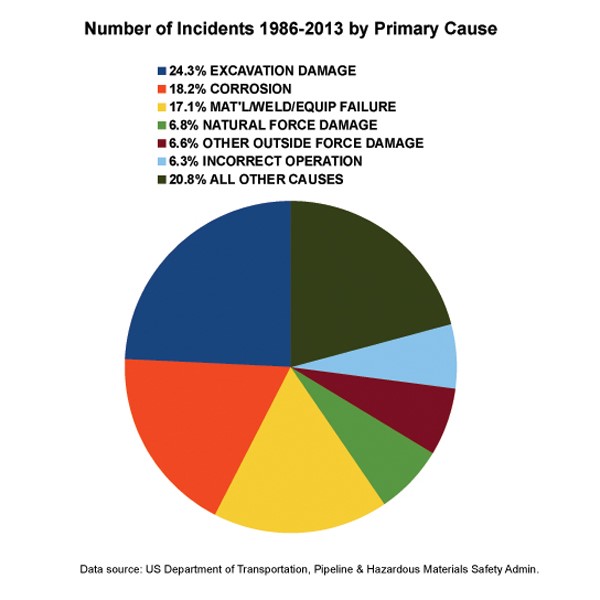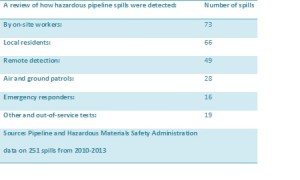October 2015, Vol. 242, No. 10
Features
New Integrity Solutions Facing Many Same Old Problems

The protection of oil, gas and refined product pipelines against natural events such as earthquakes, hurricanes and tsunamis, not to mention human actions including construction excavations, illegal tapping and terrorist sabotage, is an ongoing concern for operators around the world.
However, in the United States, the top three causes of pipeline failure reported by the Pipeline and Hazardous Materials Safety Administration (PHMSA) are construction excavations, corrosion and equipment failure (Figure1).
The consequences of a breach in a pipeline can be costly and even deadly. In the United States alone, leaks released 69 Bcf of natural gas into the atmosphere, almost enough to meet the state of Maine’s gas needs for a year, according to Forbes. Likewise, over 119,000 barrels of oil were spilled during 623 accidents, according to PHMSA.
In April 2015, a construction crew accidentally ruptured a natural gas transmission line in Fresno, CA, sparking an explosion and fire that injured five people, four of them critically.
Tackling the Problem
How to adequately maintain the integrity and security of pipelines has proved to be a longstanding challenge for operators everywhere. Traditional pipeline security measures include aerial surveillance by helicopters, satellites, and more recently, drones.
There are also on-the-ground actions such as deployment of security personnel, installation of pipeline warning boards and markers, and awareness campaigns to educate those alongside pipeline routes.
Although control rooms constantly monitor pipelines through leak-detection software and special alarms, technicians detected only 19.5% of the 251 spills in the United States between 2010 and 2013, according to the Wall Street Journal. In fact, most alarms were raised by on-site employees and residents who were nearly three times as likely to be the first to spot trouble (Table 1).

Table 1 Source: Center for Biological Diversity
Smart Pipes
In advanced western countries, the “Internet of Things (IoT)” has stimulated the development of technology to monitor and detect problems before they develop. For example, pipelines are made “smart” with supervisory control and data acquisition (SCADA) systems, while the latest IoT technology can sense, control and react to changes in the pipe’s systems and prevent leaks.
Many pipeline operators have installed distributed acoustic sensing (DAS) systems. Essentially, this is a network of fiber optic-linked sensors placed along a pipeline attached to valves, pumps and controllers that monitor not only the state of the pipeline, but also detect potential threats from tiny cracks, corrosion or metal loss.
In effect, the fiber optic cable is a closed communication network of linked sensors and an effective listening device with its acoustic array of microphones located every 10 meters, which are all GPS-located.
“Using a mix of ground penetration radar, the system can pick up along any given 10-meter section along the pipeline, whether a gas leak is taking place, a man is walking his dog nearby or someone is using a digger to get to the pipeline,” said Laurence Summers of safety specialists Westminster International Ltd.
Where a security threat is indicated, a controller can send a drone to determine its size and what needs to be done. A controller who ignores an alert caused by theft, for example, as is often the case in Mexico, is automatically bypassed by the system’s software and an alert is sent up the chain of command, thereby circumventing local neglect.
The DAS system has two key elements: an optical interrogator unit and an acoustical processing unit. The interrogator unit sends a pulse of light down the fiber optic line, with most of the light reaching the other end. However, a small percentage of light returns to the source – this effect is called “backscatter.”
Sound or vibration near the fiber changes the backscattered light, and these changes are analyzed by the interrogator unit to re-create the sound or vibration that caused them. The sounds are sent to the acoustical processing unit, which analyzes the sounds using sonar-processing algorithms to create specific alarms for a given event or sequence of events.
The passive nature and inherent long-term reliability of fiber optics, together with the ability to string together thousands of individual sensing elements in individual optical fibers, make DAS a compelling technology for pipeline monitoring and security requirements. The most advanced DAS-based solutions are designed to perform acoustic sensing for pipeline condition monitoring and leak detection on the same strand of fiber, making them ideal for retrofit projects with existing cable installations.
These systems can also cover up to 50 miles of cable between power and network connections. DAS is regarded by many operators as an effective monitoring system because it is faster and sends fewer false alarms.
Other Measures
Other measures focus on preventing leaks and ruptures in the first place by using wraps, sacrificial anodes and impressed current. The industry already uses robotic devices called “smart pigs” to crawl through a pipeline, cleaning, clearing debris and taking measurements to detect any problems.
Smart pigs may measure several different things from inside a pipe, including restrictions and deformations of the pipe, as well as metal loss. Smart pigs have increased the frequency of inspections and can locate faults. However, smart pigs cannot detect every pipeline flaw, and not all pipelines can accommodate smart pigs. Because of this, operators do not routinely run the devices through every line.
While fiber optic sensors and pigs can collect huge amounts of data on the status of a pipe, cloud analytic software rapidly reduces and analyzes the data presented in graphs, charts and diagrams.
Outside the United States
In regions where terrorism, sabotage and theft are prevalent, the standard preventative measure remains the deeper burial of pipelines.
“This will not stop the determined terrorist, but it might delay them to allow time for the activity to be picked up, and to send security forces,” said energy consultant Mike Madden, managing director at MJM Energy.
Madden recommends a range of preventative strategies to his clients, including helicopter flights over the pipeline, “walking the line” by pipeline technicians and vantage point surveys.
“In some sense, the old ways are still the best,” he said.
Author: Nicholas Newman is an Oxford-based energy journalist with experience in the technology, geopolitics, markets and policies involved in the global energy industry business.





Comments